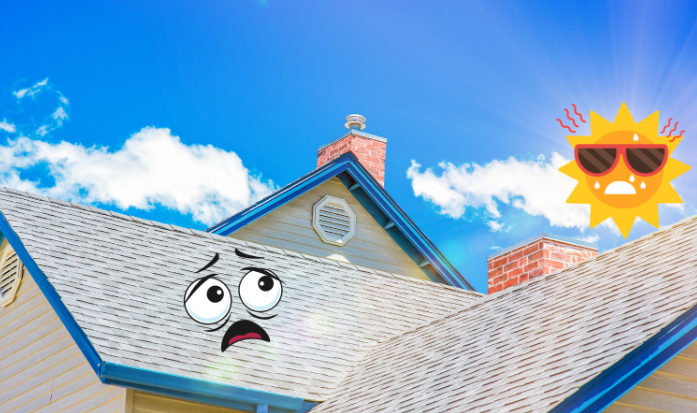Effects of Summer Heat on Your Roof
Discover the impact of summer heat on the condition and lifespan of your roof.
Understanding Roof Temperature Changes
Roofs can reach extremely high temperatures during the summer months due to the direct exposure to the sun's rays. The temperature of a roof can easily exceed the ambient temperature by 50 to 90 degrees Fahrenheit. Understanding the changes in roof temperature is crucial for assessing the potential impact on your roof's condition and lifespan.
When the sun shines on a roof, the roofing materials absorb the solar energy, causing the temperature of the roof to rise. The type of roofing material used can affect how much heat is absorbed and how quickly the heat dissipates. For example, asphalt shingles tend to absorb more heat compared to metal roofs.
Roof temperature changes can also be influenced by factors such as the color of the roof, insulation, and ventilation. Dark-colored roofs, for instance, tend to absorb more heat compared to lighter-colored roofs, leading to higher roof temperatures.
Understanding how roof temperature changes can affect your roof's performance and longevity is essential for taking appropriate measures to protect and maintain your roof.
Common Issues Caused by Summer Heat
The intense heat during the summer months can lead to several common issues with roofs. These issues include:
1. Thermal expansion and contraction: The constant heating and cooling of the roof materials can cause them to expand and contract, which can lead to cracks, splits, and other forms of damage.
2. Roof leaks: The extreme heat can cause the roofing materials to deteriorate over time, making them more susceptible to leaks. The expansion and contraction of the roof materials can also create gaps and openings where water can penetrate.
3. Shrinkage: Certain roofing materials, such as single-ply membranes, can shrink under high temperatures. This can lead to the separation of seams and joints, compromising the integrity of the roof.
4. Blistering: The combination of heat and moisture can cause the roofing materials to blister, which can eventually lead to cracks and leaks.
By being aware of these common issues caused by summer heat, you can take proactive measures to prevent or address them before they escalate and cause significant damage to your roof.
Importance of Roof Maintenance in Summer
Proper roof maintenance is crucial, especially during the summer months when your roof is exposed to high temperatures. Here are some reasons why roof maintenance is important in summer:
1. Preserve roof lifespan: Regular maintenance helps to identify and address any issues early on, preventing them from worsening and extending the lifespan of your roof.
2. Prevent leaks and water damage: Summer storms can bring heavy rainfall, and a well-maintained roof is better equipped to withstand the downpour and prevent water from seeping into your home.
3. Maintain energy efficiency: A well-maintained roof with proper insulation and ventilation can help keep your home cooler in the summer, reducing the load on your air conditioning system and saving energy.
4. Enhance curb appeal: A clean and well-maintained roof adds to the overall aesthetic appeal of your home, boosting its curb appeal and potential resale value.
Investing in regular roof maintenance during the summer is a proactive approach to ensure the longevity and performance of your roof, as well as the protection of your home and belongings.
Tips for Protecting Your Roof from Heat Damage
Taking steps to protect your roof from heat damage can help prolong its lifespan and prevent costly repairs. Here are some tips to consider:
1. Choose the right roofing materials: Opt for materials that are designed to reflect heat, such as light-colored or reflective roofing materials. These can help reduce the amount of heat absorbed by your roof.
2. Ensure proper insulation: Adequate insulation in your attic can help regulate the temperature in your home and prevent excessive heat from reaching your roof.
3. Improve ventilation: Proper ventilation allows hot air to escape from your attic, reducing the heat buildup in your roof. Consider installing vents or fans to improve airflow.
4. Provide shade: Planting trees or installing shade structures near your home can help provide additional shade and reduce the direct exposure of your roof to the sun's rays.
5. Schedule regular roof inspections: Professional roof inspections can help identify any issues or potential problems early on. Regular inspections, especially before and after the summer season, can help catch and address heat-related damage.
By implementing these tips, you can minimize the impact of summer heat on your roof and ensure its longevity and performance.
Benefits of Professional Roof Inspections
Professional roof inspections offer numerous benefits when it comes to protecting your roof from summer heat and other potential issues. Here are some key advantages:
1. Early detection of problems: Trained professionals can identify signs of damage or wear that may not be apparent to the untrained eye. Early detection allows for timely repairs or maintenance, preventing further damage.
2. Thorough assessment: Professional roof inspections involve a comprehensive evaluation of your roof's condition, including checking for leaks, cracks, loose shingles, and other potential vulnerabilities.
3. Expert advice and recommendations: Roofing professionals can provide valuable advice and recommendations on maintenance practices, materials, and potential upgrades to enhance your roof's performance and longevity.
4. Peace of mind: Regular professional inspections give you peace of mind, knowing that your roof is in good hands. You can have confidence in the condition of your roof and its ability to withstand the summer heat and other weather conditions.
Investing in professional roof inspections is a wise decision to ensure the optimal performance and durability of your roof, protecting your home and investment in the long run.


